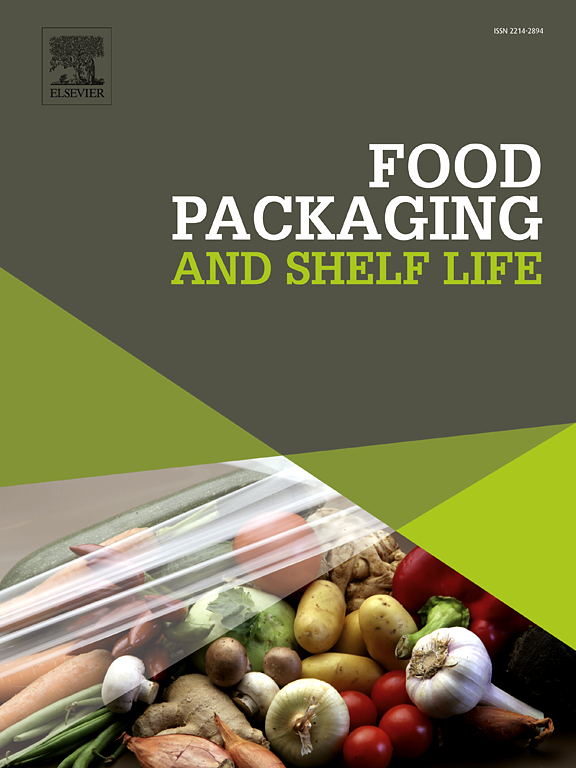希腊沙拉 "可食用薄膜的开发与表征
IF 8.5
1区 农林科学
Q1 FOOD SCIENCE & TECHNOLOGY
引用次数: 0
摘要
成功制备了由番茄泥、黄瓜汁、甜椒汁和洋葱汁、牛至油和苹果果胶制成的 "希腊沙拉 "食用薄膜,并对其透湿性、透氧性、拉伸性能、吸湿等温线、热封能力和颜色进行了表征。结果发现,在基本薄膜中加入橄榄油会增加其水蒸气渗透性,而加入瓜尔胶则没有影响。添加橄榄油和瓜尔豆胶会影响薄膜的拉伸性能、吸湿等温线和颜色。所有薄膜都具有良好的热封性能。薄膜的傅立叶变换红外光谱显示出一些有趣的特征,证实了薄膜的成分。对四种可食用薄膜进行的感官评估显示,所有样品在大多数感官属性上的得分都接近或超过 3 分(0-5 分),表明小组成员普遍可以接受。值得注意的是,含有瓜尔胶的薄膜表现出更高的均匀度和透明度,而含有橄榄油的薄膜则表现出最高的气味、风味和口感强度,但也有更明显的缺陷和不良后味。总之,在基本薄膜中添加橄榄油和瓜尔豆胶的优势并不明显。今后的实验将集中于优化基本薄膜的生产,并探索将其用于包装含油食品的可能性。本文章由计算机程序翻译,如有差异,请以英文原文为准。
Development and characterization of “Greek Salad” edible films
“Greek salad” edible films, made from tomato puree, juices of cucumber, bell pepper and onion, oregano oil and apple pectin with and without olive oil and guar gum were successfully prepared and characterized for water vapor permeability, oxygen permeability, tensile properties, moisture sorption isotherm, heat sealing ability and color. It was found that the addition of olive oil to the basic film increased its water vapor permeability, while the incorporation of guar gum had no impact on it. The addition of olive oil and guar gum affected the tensile properties, the isotherms for moisture sorption and the color of the films. All films demonstrated good heat-sealing properties. The FTIR spectra of the films displayed several interesting characteristics, confirming the films’ composition. The sensory evaluation of the four edible films revealed that all samples scored close to or above 3 (on a scale of 0–5) in most sensory attributes, indicating general acceptability among panelists. Notably, films containing guar gum exhibited higher homogeneity and transparency, while films containing olive oil showed the highest odor, flavor, and taste intensities, but also more pronounced defects and undesirable aftertastes. The basic film appeared more balanced in most sensory attributes.
It was concluded that overall the advantages of adding olive oil and guar gum to the basic film were not significant. Future experiments will concentrate on optimizing the production of the basic film and exploring the possibility of using it for packaging oily foods.
求助全文
通过发布文献求助,成功后即可免费获取论文全文。
去求助
来源期刊

Food Packaging and Shelf Life
Agricultural and Biological Sciences-Food Science
CiteScore
14.00
自引率
8.80%
发文量
214
审稿时长
70 days
期刊介绍:
Food packaging is crucial for preserving food integrity throughout the distribution chain. It safeguards against contamination by physical, chemical, and biological agents, ensuring the safety and quality of processed foods. The evolution of novel food packaging, including modified atmosphere and active packaging, has extended shelf life, enhancing convenience for consumers. Shelf life, the duration a perishable item remains suitable for sale, use, or consumption, is intricately linked with food packaging, emphasizing its role in maintaining product quality and safety.
 求助内容:
求助内容: 应助结果提醒方式:
应助结果提醒方式:


